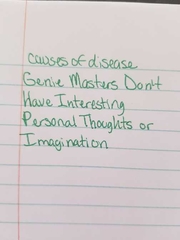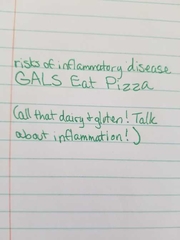![]()
![]()
![]()
Use LEFT and RIGHT arrow keys to navigate between flashcards;
Use UP and DOWN arrow keys to flip the card;
H to show hint;
A reads text to speech;
99 Cards in this Set
- Front
- Back
|
Health |
Condition of homeostasis resulting in state of physical, emotional, social and spiritual well-being |
|
|
Homeostasis |
Relatively constant state of the internal environment of the body that is maintained by adaptive responses. |
|
|
Asian homeostasis theory |
Yin/yang Life elements: fire, earth, metal, water, wood |
|
|
Ayruveda |
Right living Ether(space), air, fire, water, earth |
|
|
Doshas |
Certain elements can combine to create physiological functions Vata, Pitta, Kapha |
|
|
Vata |
Ether and air Movement- nerve impulses, circulation, respiration, elimination |
|
|
Pitta |
Fire and water Transformation- metabolism |
|
|
Kapha |
Water and earth Holds cells together, build muscle, fat and bones, some protective linings and fluids (CSF) |
|
|
Stress |
Any stimulus that creates imbalance in internal environment Requires change or response to prevent imbalance Cause hypothalamus make corticotropin releasing hormones |
|
|
Feedback loop |

|
|
|
Positive feedback loop |
Enhances stimulus Pain-spasm-more pain Example- labor and delivery |
|
|
Negative feedback loop |
Decreases stimulus |
|
|
Biological rhythms |
Internal periodic timing components of organism generated in body Circadian, ultradian, seasonal Controlled by negative feedback loops |
|
|
Circadian rhythm |
24 hours Coordinate daily cycles and sleep |
|
|
Ultradian rhythm |
90 mins-3 hours When you've been resting, urge to get up and move |
|
|
Seasonal rhythm |
Annual |
|
|
Afferent nerve |
Send signal from sensor mechanism to control center |
|
|
Efferent nerve |
Send signal from control center to effector mechanism Baroreceptors |
|
|
Entrainment |
Coordination or synchronization to internal or external rhythms When experiencing positive emotional state biological rhythms begin to oscillate together Similar effect with massage especially with rhythmic ordered approach, 45-90 massage works with ultradian rhythm Yoga, Qigong |
|
|
Pathology |
Study of disease |
|
|
Disease |
Abnormality in function of the body especially when it threatens well-being |
|
|
Acute disease |
Specific beginning and end Develops quickly Lasts short time |
|
|
Chronic disease |
More than 6 months Vague onset, develops slowly Lasts for a long time, maybe whole life Can come and go |
|
|
Subacute disease |
Between acute and chronic |
|
|
Congenital disease |
Present at time of birth |
|
|
Genetic disease |
Inherited through DNA |
|
|
Communicable disease |
Contagious |
|
|
Syndrome |
Set of signs and symptoms that identify pathological condition, especially when there is a common cause |
|
|
Signs |
Objective Can be seen or measured by someone other than client |
|
|
Symptoms |
Subjective Changes noticed or felt only by the client |
|
|
Biochemical lesions |
Changes in chemistry of body Caused by biochemical compounds such as antigen, antibody, abnormal enzyme or hormone that is altered sufficiently in disease to aid in diagnosing |
|
|
Structural lesion |
Altered organic structures Mass, pustules, tumors, ECT |
|
|
Progression of disease |
Diagnosis Prognosis Incubation Covalescence Remission |
|
|
Diagnosis |
Medical professional categorizes disease by identifying signs and symptoms |
|
|
Prognosis |
Expected outcome of a client with a disease |
|
|
Incubation |
Period of time where disease is contagious |
|
|
Convalescence |
Period of recovery |
|
|
Remission |
Reversal of signs and symptoms, may occur in chronic disease Can be temporary or permanent |
|
|
Epidemiology |
Study of transition, movement, frequency, occurrence or distribution of a disease |
|
|
Etiology |
Study of factors in cause of disease |
|
|
Idiopathic |
Disease with undetermined cause |
|
|
Pathogenesis |
Development of disease |
|
|
Pharmacology |
Preparation and action of medications to treat or prevent disease |
|
|
Causes of disease |

Genetic Malnutrition Degeneration Hypersensitivity Immune suppression/ deficiency Pathogenic organism Tumor Inflammatory response |
|
|
Genetic cause of disease |
Altered or mutated genes can cause abnormalities |
|
|
Malnutrition |
Imbalanced or insufficient intake of nutrients |
|
|
Degeneration |
Tissue breakdown unknown cause Age, arthritis |
|
|
Hypersensitivity |
Autoimmunity- immune system attacks the body Allergy-immune system hypersensitive to harmless environment antigens |
|
|
Immune suppression/deficiency |
Failure of immune system to defend body from pathogens Usually characterized by recurring severe infections or cancer |
|
|
Pathogenic organisms |
Parasitic organisms and other infectious agents |
|
|
Pathogenicity |
Ability of infectious agents to cause disease |
|
|
Virulent |
Organisms that easily cause disease |
|
|
Opportunistic pathogens |
Only thrive and cause disease when immunity is low |
|
|
Neoplasm |
Tumor Results from hyperplasia |
|
|
Hyperplasia |
Abnormal tissue growth from uncontrolled cell division |
|
|
Benign tumor |
Encapsulated Depending on location, can interfere with function by crowding or blocking or press on pain sensitive structures |
|
|
Malignant tumor |
Non encapsulated Invades surrounding tissue Can metastasize Can spread in lymph and blood Anaplasia |
|
|
Metastasize |
Break away from primary tumor and form secondary cancer mass |
|
|
Anaplasia |
Mistake in cells Creates abnormal cells that fail to mature into specialized type These cells can invade other tissue |
|
|
Factors that can cause cancer |

Age Carcinogens Environment Genetic factors |
|
|
Antineoplastics |
Chemotherapy medication used to treat cancer |
|
|
Inflammatory response |
Body's response to disturbances Speeds recovery Minimize tissue injury Heat/redness Swelling/pain Edema Exudate |
|
|
Heat/redness |
Damaged tissue releases inflammation chemicals(mediators) Some cause blood vessels to dilate(vasodilation) increasing blood volume in tissue Allows immune system cells in blood to travel quickly to injury site |
|
|
Swelling / pain |
Some inflammation mediators increase permeability of blood vessel walls allowing water to leak into tissue(swelling) Dilutes irritant Pressure from swelling can cause pain |
|
|
Vasodilation |
Blood vessels dilate for quick response to injury |
|
|
Antibodies |
Proteins that mark pathogens so other cells know to destroy them |
|
|
Edema |
Swelling |
|
|
Lymph nodes - inflammatory response |
Nodes enlarge as bacteria and damages cells are held there and destroyed by white blood cells |
|
|
Inflammatory exudate |
Fluid that accumulates in inflamed tissue Diluting irritant Removed slowly by lymphatic vessels Serous exudate Purulent exudate |
|
|
Serous exudate |
Clear, low protein content |
|
|
Purulent exudate |
Pus Yellow/white fluid, fibrous, thick and sticky Masterwork of protein |
|
|
Tissue repair |
After irritant is eliminated dead cells are replaced with living Regeneration Replacement |
|
|
Regeneration |
Parenchymal cells perform normal tissue function Damaged cells replaced with similar cells |
|
|
Replacement |
Stromal cells provide structure New cells formed with collagen Can leave a scar |
|
|
Systemic inflammatory disease |
Irritant spreads through body or causes changes in other areas |
|
|
Chronic inflammation |
Inflammation longer than 6 weeks Such as arthritis, autoimmune Can cause sinus, fistula, fibrosis, ulcer |
|
|
Sinus |
Tract leading from cavity to surface Naturally occurring in skull |
|
|
Fistula |
Tract that's open at both ends Allows abnormal connection between to surfaces |
|
|
Fibrosis |
Fibroblasts produce collagen and fibrous tissue, scar tissue and adhesions |
|
|
Ulcer |
Surface covering of organ tissue is lost due to cell death, replaced by inflammatory tissue |
|
|
Inflammation treatments |
Anti-inflammatory and steroids treat inflammation Aspirin and antihistamine suppress inflammatory response |
|
|
Risk factors of inflammatory disease |

Genetic factors Age Lifestyle Stress Environment Preexisting conditions |
|
|
Pain |
Not easy to define or measure Complex, private and abstract |
|
|
Nocirecptors |
Sensory and pain Branching ends of dendrites of certain sensory neurons informs of tissue damage |
|
|
Hyperalgesia |
Increased sensitivity to pain |
|
|
Somatic pain |
From receptors in skin, skeletal muscle, joints, tendons and fascia |
|
|
Visceral pain |
From receptors in viscera (internal organs) |
|
|
Referred pain |
Pain felt in surface far from stimulated organ |
|
|
Acute pain |
Warning for body Temporary Sudden onset Localized |
|
|
Chronic pain |
Persists or recurs More than 6 months Obscure onset |
|
|
Intractable pain |
Doesn't respond to treatment |
|
|
Phantom pain |
Pain seeming to come from amputated limb |
|
|
Adaption |
Way that body reacts to stress, internal or external, gets better over time |
|
|
General Adaption Syndrome |
Hans Selye Stages: alarm reaction Resistance reaction Exhaustion |
|
|
Alarm reaction |
Fight or flight (sympathetic nervous response) Epinephrine, adrenaline Pupils dilate, heart rate and BP increase, sweat, muscles tense |
|
|
Resistance reaction |
Secondary release of glucocorticoids Cortisol Allows body to keep fighting |
|
|
Exhaustion reaction |
Depletion of stress hormones Prolonged chronic stress Weakened immune system Increased risk for high BP, stroke, heart disease and depression |
|
|
Pain threshold |
When stimulation becomes intense enough to initiate the firing of pain receptors |
|
|
Pain tolerance |
Response to pain, varies widely |

